Step by step tutorial with photos for a fool-proof homemade apple yeast bread made with fresh apples. The best bread you’ll ever try!
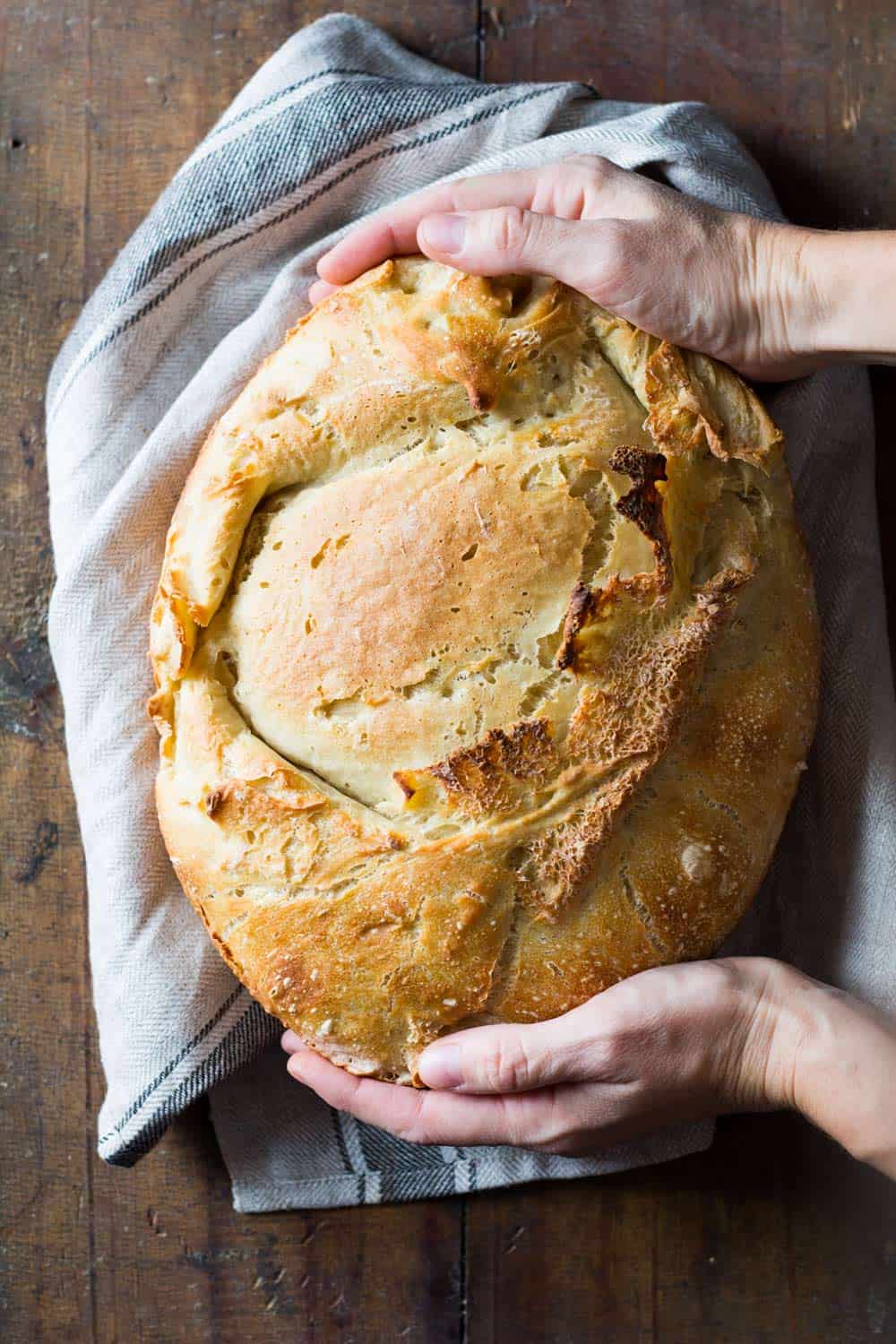
Most apple bread recipes are made with simply baking powder and the consistency is, um, no, just NO! It’s not like bread!! It’s like banana bread but not as good. Banana bread can be a dessert and “caky” (is that a word). Apple bread should be a “real” bread though in my opinion. A yeast bread!
Let’s get to the step-by-step instructions here:
Make a starter
Bread made with a starter is beyond delicious and so much superior to any other form of bread! The consistency of a bread made with a starter is completely different. Make a starter. Just do it!
Mix the necessary ingredients and leave at room temperature for at least 12 hours. Let the yeast do its magic.
After 12 hours of leaving the flour and proofed yeast in a bowl covered with a kitchen towel at room temperature, it should look like this (if it doesn’t you didn’t proof your yeast, naughty you!).
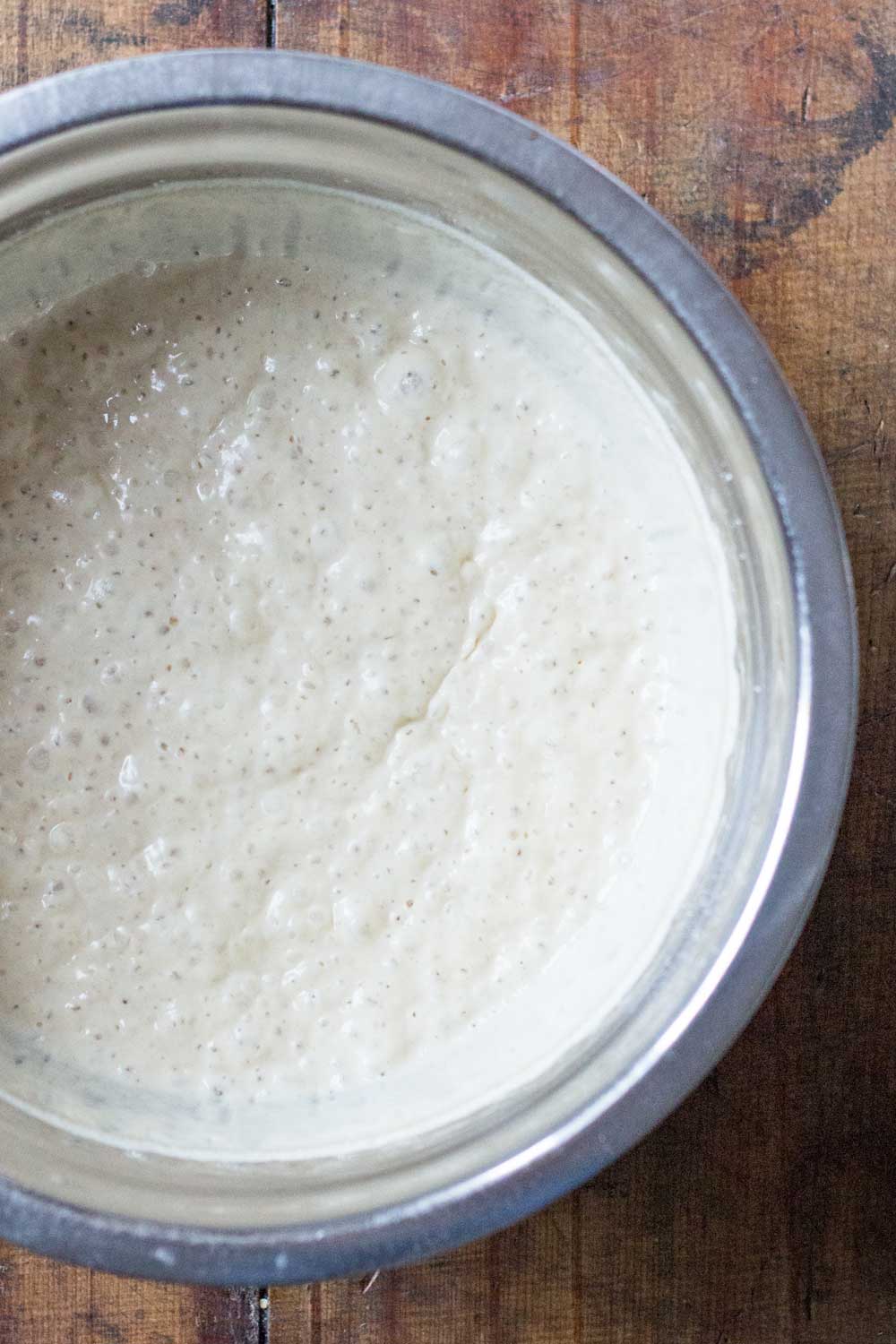
Make it an “Artisan Bread”
Artisan yeast apple bread requires several rises. This specific bread calls for a 12-hour rise of the starter and then two 45-minute rises.
Remember, you don’t have to do anything at all while the bread is rising. Making bread is a long process BUT only requires a couple of minutes of actual work in between rising/resting time. In total, you put in maybe 10 minutes of active work here.
Use a stand mixer to knead the starter and rest of ingredients with a dough hook attached for a good 20 minutes on low. This is so the gluten is activated. You can’t do this by hand. The dough is too sticky and also, you’d need a bodybuilder’s muscle to make it through 20 minutes of kneading. If you don’t have a stand mixer ask around and borrow one from a friend.
The dough should end up very sticky and elastic (left photo). Cover it with a clean kitchen towel and let rise at room temperature for 45 minutes or until the dough has doubled in size (right photo).
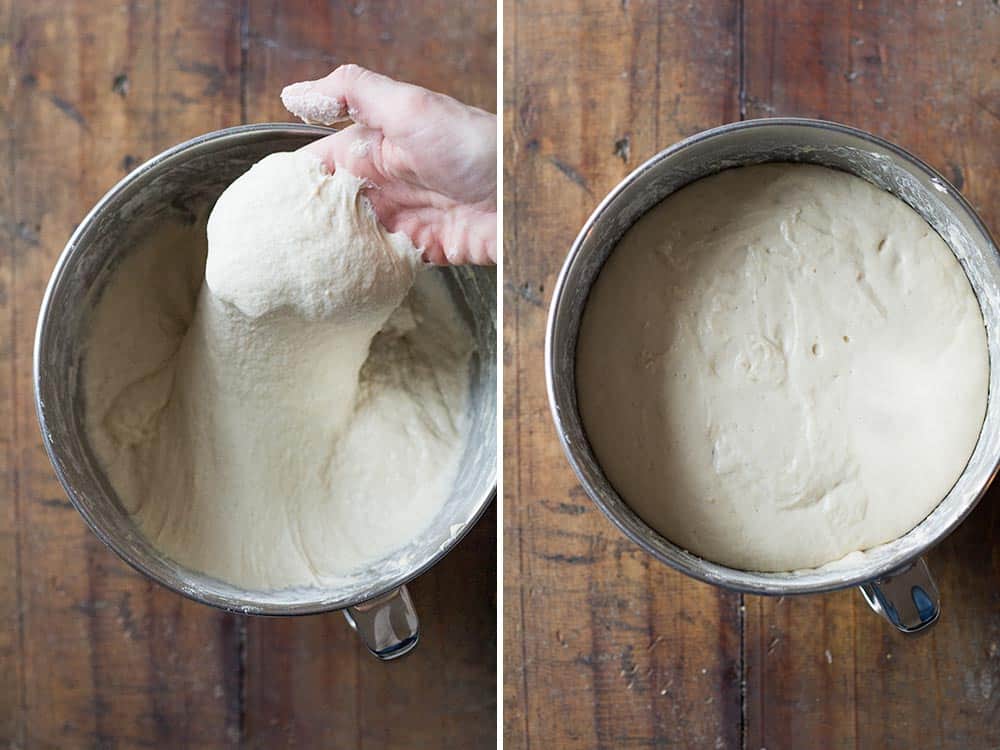
When and how to add fresh apples to the bread dough
After the first rise, it’s time to fold in the fresh apples.
I recommend adding the apples this late in the process to avoid fermentation. If you add the apples in earlier it will ferment and make the dough pretty sour. I wonder also if the dough would even rise the first time due to the weight of the apples. It’s best to let the dough rise first, then add apples, then let it rise again.
Add apples and fold and fold until well combined. By then the dough reduced in size again. Tadaaa, the photos for how to add fresh apples to healthy apple bread:
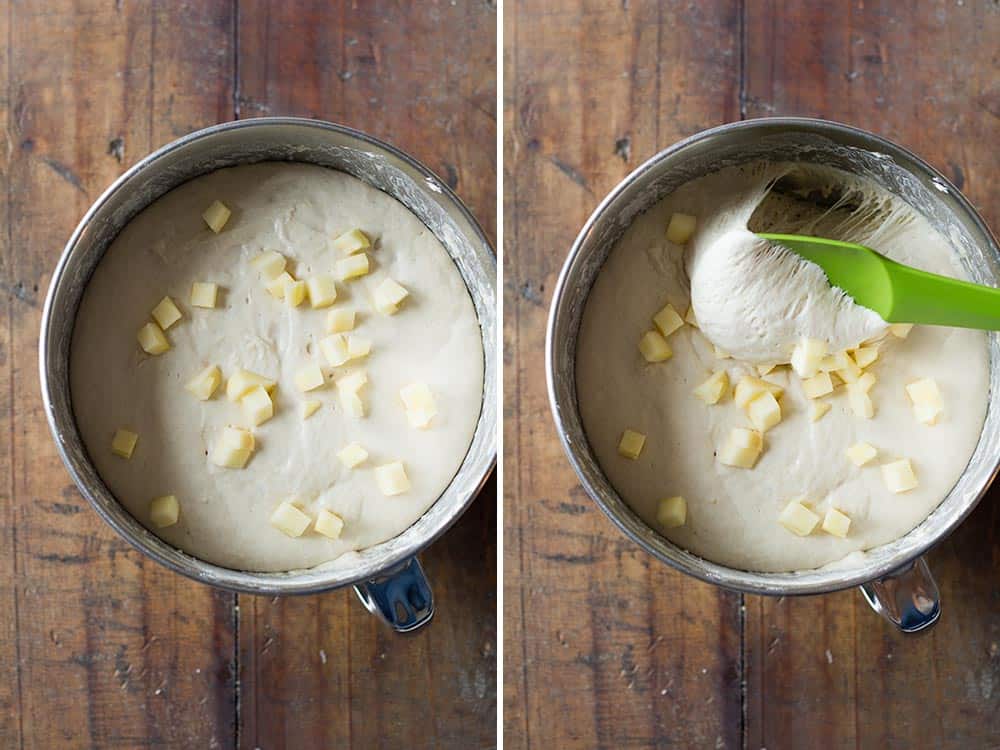
You can leave the dough in the same bowl for the second rise but I prefer dumping it into another parchment paper-lined bowl for easier and risk-free transfer into the burning hot dutch oven later.
It’s so much easier to lift the dough out with the parchment paper and then turn around and dump in the dutch oven. I guess you could even dump it in just like that with the parchment paper at the bottom. I prefer to remove. Just in case. So it doesn’t stick?
Anyway. I dump it into a parchment paper-lined bowl, cover with the kitchen towel again and let it rise a second time for about 45 minutes. 15 minutes into the second rise I turn on the oven with the dutch oven inside for it to heat up properly.
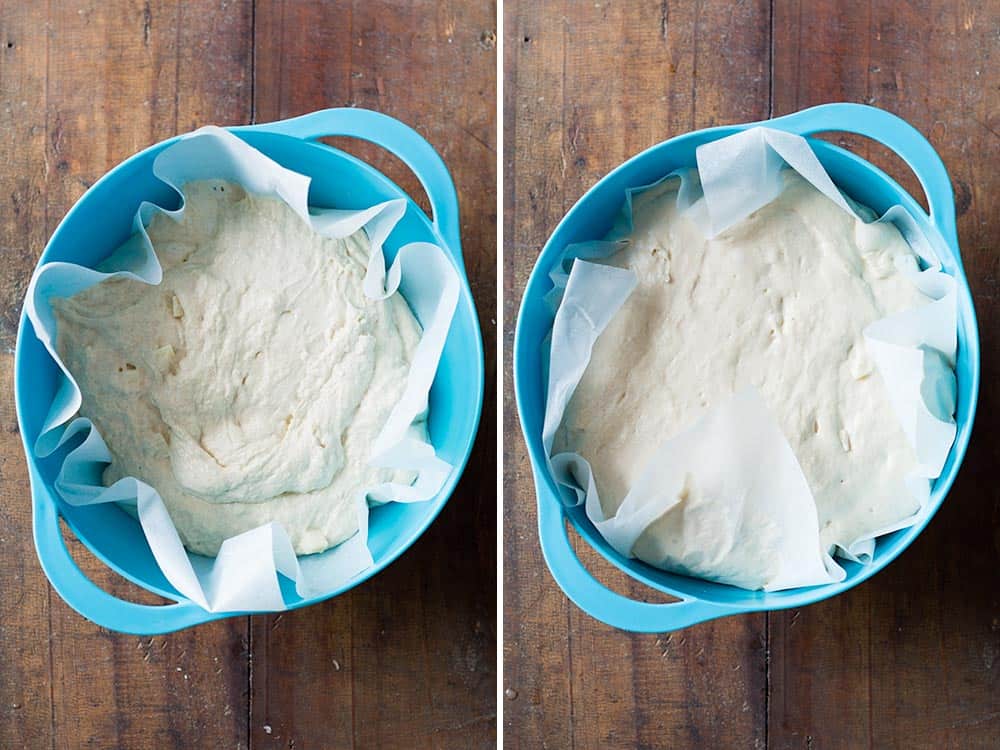
Dutch oven vs. no dutch oven when making bread
There are two reasons apple yeast bread or any yeast bread really will form a dome. One, the bread dough is given enough opportunities to rise. Two, the bread dough is baked in strong heat coming from all directions. Most of us have regular ovens. Heat from the top and heat from the bottom. That’s it. Regular home ovens do not emit heat from all around. Bakeries have special ovens. Many of their ovens are stone ovens where the stone retains all the heat and radiates it back to the whole surface of the bread.
The only way to “imitate” this is by using a dutch oven. I’ve tried with a oven-proof stainless steel pot with oven-proof glass lid and … it doesn’t work. Stainless steel doesn’t “store” heat. It becomes hot, yes, but as soon as you take it out of the oven to dump in the bread dough, it immediately starts cooling down. A cast-iron pot keeps the heat for muuuuch longer. Enough time for you to dump in the dough, put the lid back on and transfer back in the oven without it cooling down even 1 degree.
Now, if you don’t have a dutch oven, don’t go run and buy one. They are quite pricey. Ask around if someone can borrow you theirs (<- that’s what I did by the way. Thank you Sophie! :) OR if nobody can borrow you one just use your cast iron pan (I’ve done that before with this No-Knead Bread). If you don’t have either, use a baking sheet. Your bread will not produce a beautiful dome. It will for sure still taste absolutely amazing though.
One important tip: be really, really, really, really, really, really careful when taking the dutch oven out of the oven. It will be BURNING HOT! Use very thick silicone oven gloves or double up your regular cloth gloves. The burns you get from a hot dutch oven are unbelievably painful. All concentration is required here. Don’t multitask at this point. Do only ONE thing. Keep your eyes only on the oven and your body parts.
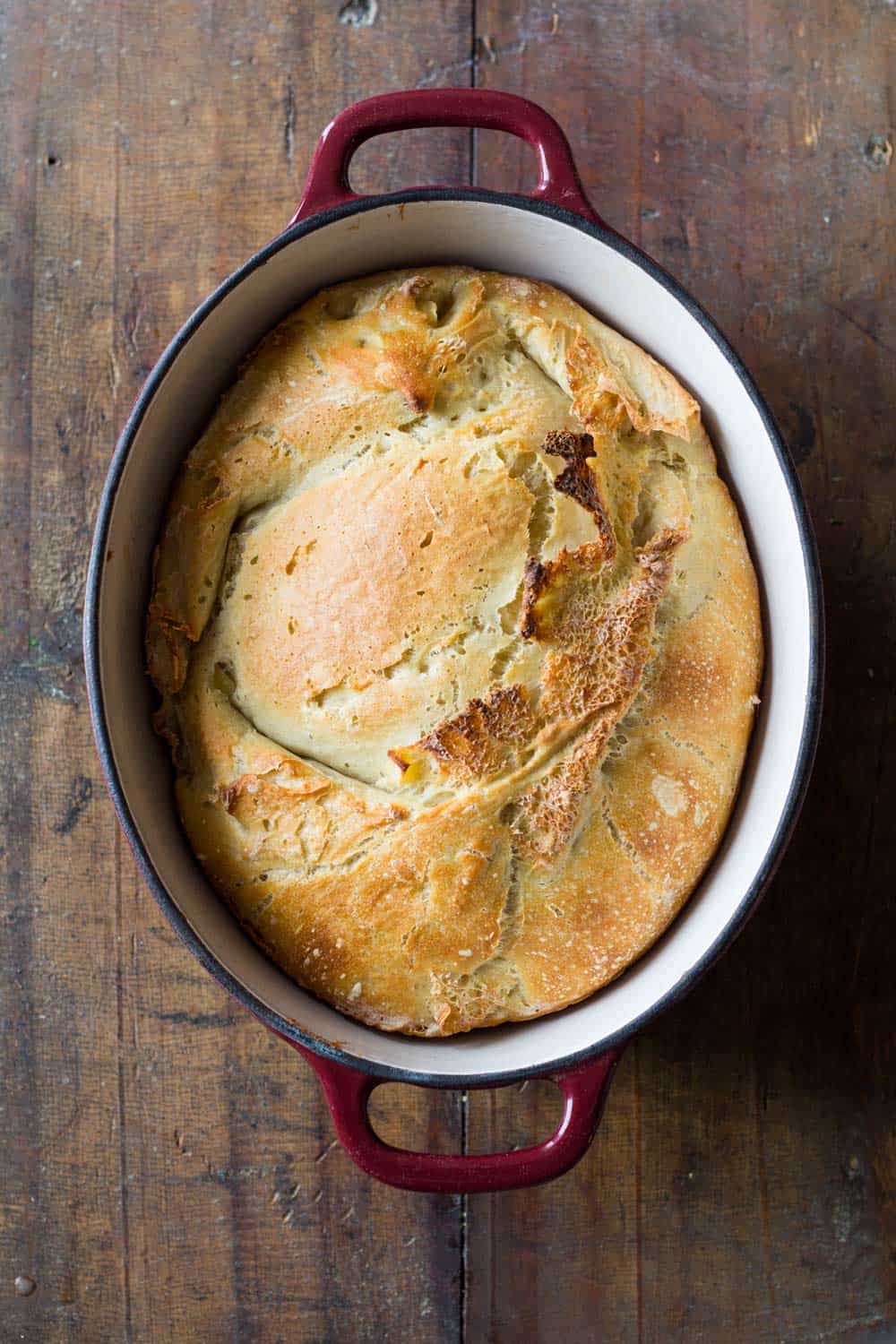
Apple Yeast Bread cooling instructions
This point is also very important. Once the apple yeast bread is baked you have to remove it from the dutch oven (carefully, remember it’s hot!). Since the dutch oven retains a lot of heat for an extended amount of time it’s crucial to remove the bread so it doesn’t continue baking. Otherwise it will become very hard. Turn the dutch oven over so the apple bread falls out. It will immediately and easily fall out. There is no way bread dough will stick to a burning hot cast iron pot or pan. If it sticks, you didn’t heat it up enough time (as I suggested further up) naughty you ;)
Place the freshly baked bread on a cooling rack and wait for it to COMPLETELY cool down before cutting into it. If you cut into hot bread all the steam escapes and the center stays “doughy”. The bread needs to cool down slowly for the steam to do it’s work on the inside of the apple yeast bread.
How to store Yeast Bread
It’s time to finally, finally break apart a piece of this masterpiece of a healthy apple bread.

Don’t use a knife. Use your hands. Eat an uneven piece. It tastes so much better that way. Eat your first piece just like that. You can eat the second with butter or dunked into butternut squash soup. Eat the first piece just plain.
Once you ate all you could eat it’s time to store it. Put it in a paper bag and leave on the kitchen counter if you’ll finish it the same day. OR place in a paper bag and then plastic bag and place in the fridge. Since this Apple Yeast Bread contains fresh apples it shouldn’t be stored on the kitchen counter for too many days. Store it in the fridge from day 2 onward.
Phew. Are you ready to make bread now?
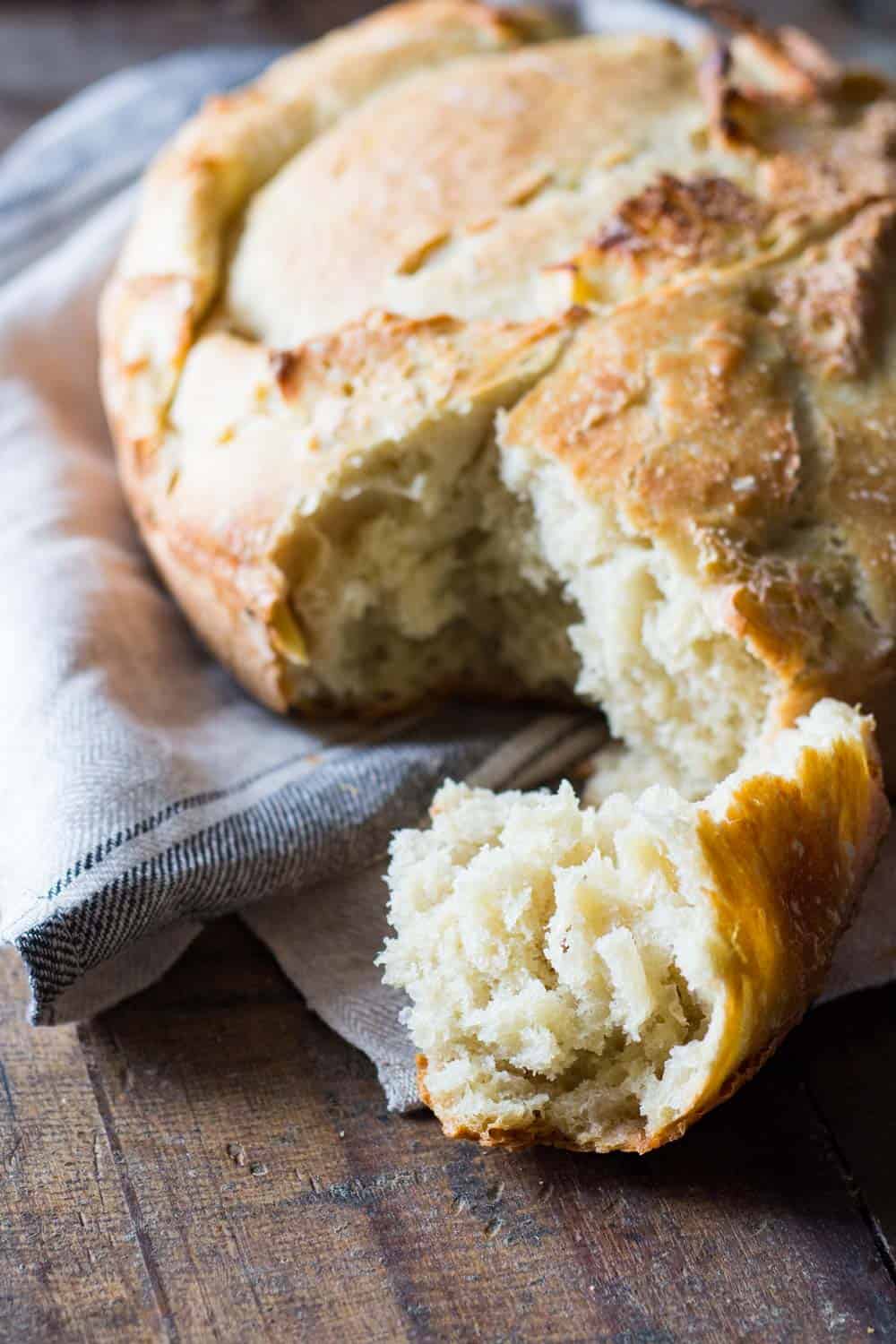
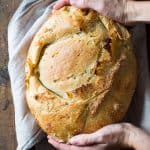
Apple Yeast Bread
Ingredients
- 220 ml (g) 100 F (38 C) warm water
- 7 g active dry yeast
- 220 g all-purpose unbleached white flour
- 800 g all-purpose unbleached white flour
- 7 g active dry yeast
- 480 ml (g) water
- 20 ml (g) milk
- 25 g sugar
- 1 pinch salt
- 1-2 large red apples
- extra flour
- cornmeal
Instructions
- Make starter In a medium bowl mix 220ml 100F-warm water (use a thermometer!) and 7g active dry yeast and let sit for 8-10 minutes until all bubbly. Then add in 220g flour and mix with a spatula. Cover with a clean kitchen towel and let rise at room temperature for 12 hours (overnight).
- Prepare the bread dough Add 800g flour, another 7g yeast salt, sugar and 480ml water and 20ml milk to the starter and knead on low for at least 20 minutes until the dough is sticky and elastic.
- First rise Cover the bowl in which the dough was kneaded with a clean kitchen towel and let rise for 45 minutes at room temperature.
- Add apples Peel and core apple, cut into small pieces and fold into the bread dough little by little.
- Second rise Transfer dough into a parchment paper lined bowl, cover with clean kitchen towel and let rise a second time for 45 minutes at room temperature. OR (preferred!): spread out a dish towel on the counter, sprinkle with abundant flour and corn meal and dump dough onto towel, then cover and let rise (see video for visual example).
- Preheat oven and dutch oven 15 minutes into the second rise preheat the oven to 450F with the dutch oven with lid inside the oven. The oven and dutch oven have to heat up at least 30 minutes.
- Bake the bread Take the dutch oven out of the oven carefully, lift the bread out of the bowl by holding the edges of the parchment paper up, turn around and dump into the burning hot dutch oven. OR take the turn the dish towel and dump the dough into the burning hot dutch oven. Place the lid on top and return into the oven. Bake 30 minutes with lid on and a further 10 minutes with lid off.
- Cool Bread Take dutch oven out of oven, remove bread from dutch oven, place on a cooling rack and let cool down completely before cutting into bread.
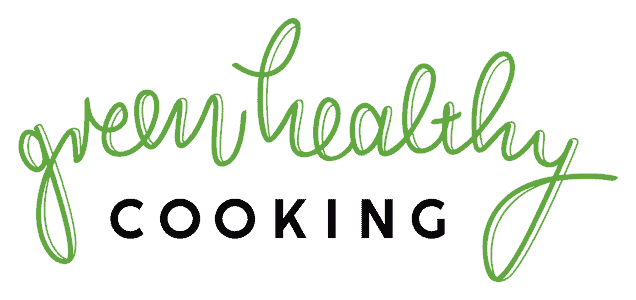

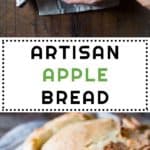
 Creamy Cucumber Salad
Creamy Cucumber Salad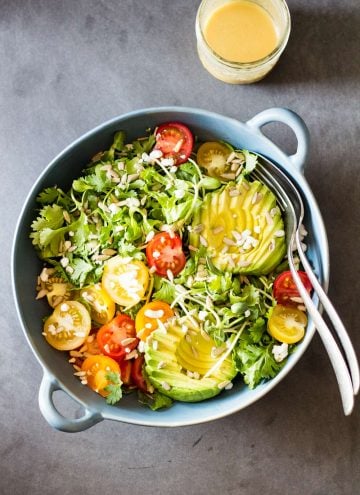 Mexican-Style Side Salad
Mexican-Style Side Salad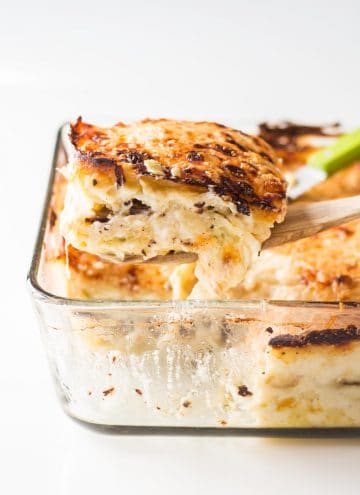 Artichoke Mushroom Lasagna with Bechamel Sauce
Artichoke Mushroom Lasagna with Bechamel Sauce
Cathy says
Will a 4 quart dutch oven work for this recipe, it looks like yours might be bigger?
Dana says
I’ve made this recipe and variations of it I think about four times now in a week and a half long period – and they all came out so good! I’ve found that I’m able to add up to 2 cups of finely chopped apples to the bread, and I’ve been tossing said apples in cinnamon and sugar and then roasting them for a bit in the oven (and then letting them cool) before adding them to the dough. It really is delicious. I agree with the other commenters that upping the salt (20-25g) is helpful as well. I also sub out some of the water for apple cider as one of the other commenters suggested – and now I do too!
I’ve also been able to substitute the two cups of apples with two cups of (similarly roasted in the oven) pumpkin puree, which was a fun one!
It’s my first time baking yeast bread, and I’m grateful to have stumbled upon this recipe as it truly has been lovely during my bread baking hyperfixation period. Thank you so much!
Dana says
Also – buttering the still-warm loaf and sprinkling cinnamon sugar over the outside?? game changer
Dana says
Do I need sugar to activate the yeast in the first step? It doesn’t seem to be getting to the bubbly stage, and I’ve tried dumping it twice now with no luck.
Dana says
You do not! It was just my first time and “bubbly” did not look like what I thought it would look like lol but it worked!
LUCKY 97 says
I love the idea of combining apples with yeast bread! It sounds like a delicious way to add some natural sweetness and moisture. Can’t wait to try this recipe! Thank you for sharing!
90CLUB says
This Apple Yeast Bread sounds absolutely delicious! I love the combination of flavors and the healthy twist. Can’t wait to try making it at home—thanks for sharing such a wonderful recipe!
101 game says
I just tried the apple yeast bread recipe, and it turned out amazing! The combination of apples and spices adds such a wonderful flavor. Thanks for sharing this delicious and healthy recipe! I can’t wait to make it again.
CMA says
I love this recipe! I added cinnamon, raisins and walnuts and stuffed it into a 4 quart cast iron pot and buttered the lid so bread wouldn’t stick incase it rose too much. It is a beautiful looking round and high loaf of bread! Tastes delicious, too!
CMA says
I also added 22 grams of salt and I can’t imagine using less. Not salty at all just enhances flavors.
Laura C Kelly says
ml? g? Really??
Anupama says
no scale? really?
Sylwia says
The bread was delicious! Great description, easy to make. I used a baking sheet and parchment paper and was ok. I baked 10 minutes longer (40 minutes) , although I think baking the 30 minutes on the parchment paper might be enough also. I’ll try it next time.
Sheila says
The bread baked great. Used oat milk to make it vegan for a friend. The taste was flat. I will try again but will add 3/4 tsp of salt. It’s time intense and sticky dough is not so much fun to work with or clean up. We’ll toast it and put jelly or cheddar cheese on it.